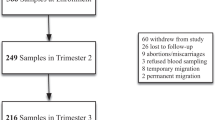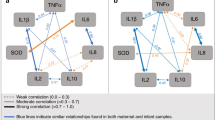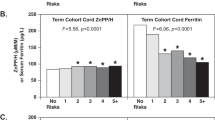Abstract
Objective:
To ascertain the effect of obesity-related inflammation on maternal and fetal iron status. We hypothesized that obese (Ob) pregnant women would have increased inflammation, hepcidin levels, and that their infants would have impaired iron status compared with lean (Lc) controls.
Study Design:
Fifteen Ob and fifteen Lc women were recruited in their second trimester of pregnancy. Markers of iron status, inflammation and hepcidin were measured in maternal and cord blood. Student's t-test was used to compare Ob and Lc groups, and Pearson's correlation coefficients were determined between maternal and cord blood values.
Result:
Maternal C-reactive protein (P<0.01) and hepcidin (P<0.01) were higher, and cord blood iron (P<0.01) was lower in the Ob group. Maternal body mass index (P<0.01) and hepcidin (P<0.05) were negatively correlated with cord blood iron status.
Conclusion:
Maternal obesity is associated with impaired maternal-fetal iron transfer, potentially through hepcidin upregulation.
This is a preview of subscription content, access via your institution
Access options
Subscribe to this journal
Receive 12 print issues and online access
$259.00 per year
only $21.58 per issue
Buy this article
- Purchase on Springer Link
- Instant access to full article PDF
Prices may be subject to local taxes which are calculated during checkout


Similar content being viewed by others
References
Catalano PM, Ehrenberg HM . The short- and long-term implications of maternal obesity on the mother and her offspring. BJOG 2006; 113 (10): 1126–1133.
Reichman NE, Nepomnyaschy L . Maternal pre-pregnancy obesity and diagnosis of asthma in offspring at age 3 years. Matern Child Health J 2008; 12 (6): 725–733.
Scholtens S, Wijga AH, Brunekreef B, Kerkhof M, Postma DS, Oldenwening M et al. Maternal overweight before pregnancy and asthma in offspring followed for 8 years. Int J Obes (Lond) 2010; 34 (4): 606–613.
Bekri S, Gual P, Anty R, Luciani N, Dahman M, Ramesh B et al. Increased adipose tissue expression of hepcidin in severe obesity is independent from diabetes and NASH. Gastroenterology 2006; 131 (3): 788–796.
Cepeda-Lopez AC, Osendarp SJ, Melse-Boonstra A, Aeberli I, Gonzalez-Salazar F, Feskens E et al. Sharply higher rates of iron deficiency in obese Mexican women and children are predicted by obesity-related inflammation rather than by differences in dietary iron intake. Am J Clin Nutr 2011; 93 (5): 975–983.
Menzie CM, Yanoff LB, Denkinger BI, McHugh T, Sebring NG, Calis KA et al. Obesity-related hypoferremia is not explained by differences in reported intake of heme and nonheme iron or intake of dietary factors that can affect iron absorption. J Am Diet Assoc 2008; 108 (1): 145–148.
Tussing-Humphreys LM, Nemeth E, Fantuzzi G, Freels S, Guzman G, Holterman AX et al. Elevated systemic hepcidin and iron depletion in obese premenopausal females. Obesity (Silver Spring) 2010; 18 (7): 1449–1456.
Yanoff LB, Menzie CM, Denkinger B, Sebring NG, McHugh T, Remaley AT et al. Inflammation and iron deficiency in the hypoferremia of obesity. Int J Obes (Lond) 2007; 31 (9): 1412–1419.
Evans P, Cindrova-Davies T, Muttukrishna S, Burton GJ, Porter J, Jauniaux E . Hepcidin and iron species distribution inside the first-trimester human gestational sac. Mol Hum Reprod 2011; 17 (4): 227–232.
Nemeth E, Rivera S, Gabayan V, Keller C, Taudorf S, Pedersen BK et al. IL-6 mediates hypoferremia of inflammation by inducing the synthesis of the iron regulatory hormone hepcidin. J Clin Invest 2004; 113 (9): 1271–1276.
Lee P, Peng H, Gelbart T, Beutler E . The IL-6- and lipopolysaccharide-induced transcription of hepcidin in HFE-, transferrin receptor 2-, and beta 2-microglobulin-deficient hepatocytes. Proc Natl Acad Sci USA 2004; 101 (25): 9263–9265.
Lee P, Peng H, Gelbart T, Wang L, Beutler E . Regulation of hepcidin transcription by interleukin-1 and interleukin-6. Proc Natl Acad Sci USA 2005; 102 (6): 1906–1910.
Luciani N, Brasse-Lagnel C, Poli M, Anty R, Lesueur C, Cormont M et al. Hemojuvelin: A new link between obesity and iron Homeostasis. Obesity (Silver Spring) 2011; 19 (8): 1545–1551.
Rehu M, Punnonen K, Ostland V, Heinonen S, Westerman M, Pulkki K et al. Maternal serum hepcidin is low at term and independent of cord blood iron status. Eur J Haematol 2010; 85 (4): 345–352.
Lozoff B, Beard J, Connor J, Barbara F, Georgieff M, Schallert T . Long-lasting neural and behavioral effects of iron deficiency in infancy. Nutr Rev 2006; 64 (5 Pt 2): S34–S43, discussion S72-91.
Pinero DJ, Li NQ, Connor JR, Beard JL . Variations in dietary iron alter brain iron metabolism in developing rats. J Nutr 2000; 130 (2): 254–263.
Shafir T, Angulo-Barroso R, Jing Y, Angelilli ML, Jacobson SW, Lozoff B . Iron deficiency and infant motor development. Early Hum Dev 2008; 84 (7): 479–485.
Ali El-Farrash R, Rahman Ismail EA, Shafik Nada A . Cord blood iron profile and breast milk micronutrients in maternal iron deficiency anemia. Pediatr Blood Cancer 2011; 58 (2): 233–238.
Challier JC, Basu S, Bintein T, Minium J, Hotmire K, Catalano PM et al. Obesity in pregnancy stimulates macrophage accumulation and inflammation in the placenta. Placenta 2008; 29 (3): 274–281.
Acknowledgements
This research has been supported by: USDA contract # 58-1950-7-707, Tufts Medical Center Research Grant and The Natalie V. Zucker Foundation for Women Scholars, Stanley N. Gershoff scholarship, NHLBI T32 Nutrition and Cardiovascular Disease Training Program.
Author information
Authors and Affiliations
Corresponding author
Ethics declarations
Competing interests
The authors declare no conflict of interest.
Rights and permissions
About this article
Cite this article
Dao, M., Sen, S., Iyer, C. et al. Obesity during pregnancy and fetal iron status: is Hepcidin the link?. J Perinatol 33, 177–181 (2013). https://doi.org/10.1038/jp.2012.81
Received:
Revised:
Accepted:
Published:
Issue Date:
DOI: https://doi.org/10.1038/jp.2012.81
Keywords
This article is cited by
-
The effect of prepregnancy body mass index on maternal micronutrient status: a meta-analysis
Scientific Reports (2021)
-
Maternal obesity and impaired offspring neurodevelopment: could fetal iron deficiency be a pathogenic link?
Journal of Perinatology (2021)
-
Baseline iron and low-grade inflammation modulate the effectiveness of iron supplementation: evidence from follow-up of pregnant Sri Lankan women
European Journal of Nutrition (2021)
-
Association of maternal BMI during early pregnancy with infant anemia: a large Chinese birth cohort
Nutrition & Metabolism (2020)
-
Impact of maternal, antenatal and birth-associated factors on iron stores at birth: data from a prospective maternal–infant birth cohort
European Journal of Clinical Nutrition (2017)



